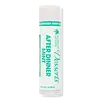What's inside
What's inside
 Key Ingredients
Key Ingredients

 Benefits
Benefits

 Concerns
Concerns

 Ingredients Side-by-side
Ingredients Side-by-side

Butyl Methoxydibenzoylmethane 3%
UV AbsorberHomosalate 5%
Skin ConditioningEthylhexyl Salicylate 3%
UV AbsorberOctocrylene 10%
UV AbsorberAloe Barbadensis Leaf Extract
EmollientButyloctyl Salicylate
Skin ConditioningC18-38 Alkyl Hydroxystearoyl Stearate
EmollientCanola Oil
EmollientCocos Nucifera Oil
MaskingEuphorbia Cerifera Wax
Aroma
Glycine Soja Oil
EmollientHelianthus Annuus Seed Wax
Skin ConditioningOlea Europaea Fruit Oil
MaskingRicinus Communis Seed Oil
MaskingRosmarinus Officinalis Leaf Extract
AntimicrobialSimmondsia Chinensis Seed Oil
EmollientStevia Rebaudiana Leaf Extract
EmollientSunflower Seed Oil Glycerides
EmollientTheobroma Cacao Seed Butter
EmollientTocopherol
AntioxidantTocopheryl Acetate
AntioxidantButyl Methoxydibenzoylmethane 3%, Homosalate 5%, Ethylhexyl Salicylate 3%, Octocrylene 10%, Aloe Barbadensis Leaf Extract, Butyloctyl Salicylate, C18-38 Alkyl Hydroxystearoyl Stearate, Canola Oil, Cocos Nucifera Oil, Euphorbia Cerifera Wax, Aroma, Glycine Soja Oil, Helianthus Annuus Seed Wax, Olea Europaea Fruit Oil, Ricinus Communis Seed Oil, Rosmarinus Officinalis Leaf Extract, Simmondsia Chinensis Seed Oil, Stevia Rebaudiana Leaf Extract, Sunflower Seed Oil Glycerides, Theobroma Cacao Seed Butter, Tocopherol, Tocopheryl Acetate
Zinc Oxide 16.5%
Cosmetic ColorantPolybutene
Caprylic/Capric Triglyceride
MaskingHelianthus Annuus Seed Wax
Skin ConditioningC9-12 Alkane
SolventDiisostearyl Malate
EmollientEuphorbia Cerifera Wax
Tridecyl Trimellitate
EmollientBis-Behenyl/Isostearyl/Phytosteryl Dimer Dilinoleyl Dimer Dilinoleate
EmollientGlyceryl Isostearate
EmollientHydrogenated Polyisobutene
EmollientDimethicone
EmollientButyrospermum Parkii Butter
Skin ConditioningBis-Diglyceryl Polyacyladipate-2
EmollientZea Mays Oil
EmulsifyingPolyhydroxystearic Acid
EmulsifyingLecithin
EmollientAscorbic Acid
AntioxidantAcetyl Glucosamine
Skin ConditioningLinoleic Acid
CleansingPunica Granatum Sterols
Skin ConditioningDipalmitoyl Hydroxyproline
Skin ConditioningDisteardimonium Hectorite
StabilisingSqualane
EmollientPolysilicone-11
Sodium Hyaluronate
HumectantTocopheryl Acetate
AntioxidantPalmitoyl Tripeptide-1
Skin ConditioningPalmitoyl Tetrapeptide-7
Skin ConditioningMoringa Oil/Hydrogenated Moringa Oil Esters
Skin ConditioningAmaranthus Caudatus Seed Oil
EmollientHordeum Distichon Extract
Skin ProtectingTriticum Vulgare Germ Oil
EmollientTriethyl Citrate
MaskingCitrus Aurantium Peel Oil
Aroma
C12-15 Alkyl Benzoate
AntimicrobialRicinoleic Acid
CleansingVanillin
MaskingSorbitan Laurate
EmulsifyingC18-36 Acid Glycol Ester
EmollientC18-36 Acid Triglyceride
EmollientTocopherol
AntioxidantBlue 1 Lake
Cosmetic ColorantCI 77491
Cosmetic ColorantCI 77492
Cosmetic ColorantCI 77499
Cosmetic ColorantCI 15850
Cosmetic ColorantCI 45380
Cosmetic ColorantCI 19140
Cosmetic ColorantZinc Oxide 16.5%, Polybutene, Caprylic/Capric Triglyceride, Helianthus Annuus Seed Wax, C9-12 Alkane, Diisostearyl Malate, Euphorbia Cerifera Wax, Tridecyl Trimellitate, Bis-Behenyl/Isostearyl/Phytosteryl Dimer Dilinoleyl Dimer Dilinoleate, Glyceryl Isostearate, Hydrogenated Polyisobutene, Dimethicone, Butyrospermum Parkii Butter, Bis-Diglyceryl Polyacyladipate-2, Zea Mays Oil, Polyhydroxystearic Acid, Lecithin, Ascorbic Acid, Acetyl Glucosamine, Linoleic Acid, Punica Granatum Sterols, Dipalmitoyl Hydroxyproline, Disteardimonium Hectorite, Squalane, Polysilicone-11, Sodium Hyaluronate, Tocopheryl Acetate, Palmitoyl Tripeptide-1, Palmitoyl Tetrapeptide-7, Moringa Oil/Hydrogenated Moringa Oil Esters, Amaranthus Caudatus Seed Oil, Hordeum Distichon Extract, Triticum Vulgare Germ Oil, Triethyl Citrate, Citrus Aurantium Peel Oil, Aroma, C12-15 Alkyl Benzoate, Ricinoleic Acid, Vanillin, Sorbitan Laurate, C18-36 Acid Glycol Ester, C18-36 Acid Triglyceride, Tocopherol, Blue 1 Lake, CI 77491, CI 77492, CI 77499, CI 15850, CI 45380, CI 19140
Ingredients Explained
These ingredients are found in both products.
Ingredients higher up in an ingredient list are typically present in a larger amount.
Aroma refers to an ingredient, or mixture of ingredients, that impart or mask a flavor.
The name is slightly confusing. This is because INCI associates aroma with flavor instead of smell.
Here is the official definition from the The International Cosmetic Ingredient Dictionary and Handbook:
“Aroma is a term for ingredient labeling used to identify that a product contains a material or combination of materials normally added to a cosmetic to produce or to mask a particular flavor.”
INCI shows the only purpose of aroma to be "flavouring".
However, due to regulation differences, some companies may use aroma in place of parfum.
In Canada, this ingredient only has to be listed in concentrations above 1%.
Learn more about AromaHelianthus Annuus Seed Wax is created from the common sunflower.
Sunflower seed wax is made up of long chain non-glyceride esters, a small amount of fatty alcohols, and fatty acids.
This ingredient is often used to enhance the texture of products. The fatty acid properties also help hydrate the skin.
Learn more about Helianthus Annuus Seed WaxTocopherol (also known as Vitamin E) is a common antioxidant used to help protect the skin from free-radicals and strengthen the skin barrier. It's also fat soluble - this means our skin is great at absorbing it.
Vitamin E also helps keep your natural skin lipids healthy. Your lipid skin barrier naturally consists of lipids, ceramides, and fatty acids. Vitamin E offers extra protection for your skin’s lipid barrier, keeping your skin healthy and nourished.
Another benefit is a bit of UV protection. Vitamin E helps reduce the damage caused by UVB rays. (It should not replace your sunscreen). Combining it with Vitamin C can decrease sunburned cells and hyperpigmentation after UV exposure.
You might have noticed Vitamin E + C often paired together. This is because it is great at stabilizing Vitamin C. Using the two together helps increase the effectiveness of both ingredients.
There are often claims that Vitamin E can reduce/prevent scarring, but these claims haven't been confirmed by scientific research.
Learn more about TocopherolTocopheryl Acetate is AKA Vitamin E. It is an antioxidant and protects your skin from free radicals. Free radicals damage the skin by breaking down collagen.
One study found using Tocopheryl Acetate with Vitamin C decreased the number of sunburned cells.
Tocopheryl Acetate is commonly found in both skincare and dietary supplements.
Learn more about Tocopheryl AcetateEuphorbia Cerifera wax comes from a shrub in Northern Mexico. It is used to stabilize formulations and has emollient properties.
Emollients form a thin layer on top of skin to prevent water from evaporating, keeping skin and lips hydrated.
According to a manufacturer, this wax can range from a yellow/brown color to translucent.
Learn more about Euphorbia Cerifera Wax